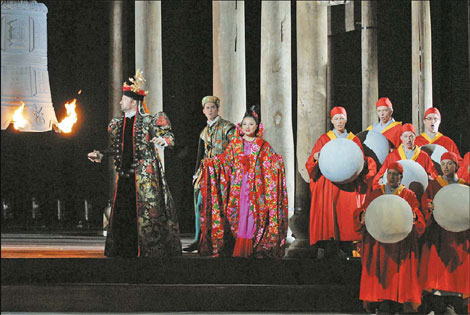Life and Leisure
Myth and fact share the same stage
By Chen Jie (China Daily)
Updated: 2010-10-22 07:59
 |
Large Medium Small |
|
Performance artist Zhang Huan's version of Semele features an international cast. Photos provided to China Daily |
The ongoing Beijing Music Festival's most challenging opera interweaves a Chinese family's story and Greek mythology, and is directed by a performance artist. Chen Jie reports
When Zhang Huan bought a 450-year-old ancestral temple from a small village in Quzhou, Zhejiang province, and moved it to his Shanghai studio some three years ago, the conceptual artist never expected that it would be re-assembled in the West. In September 2009, it graced the stage of the Theatre Royal de la Monnaie in Brussels.
And now, a year later, the ancient temple returns to its home country when the opera Semele runs at Beijing's Poly Theater from Oct 24. It will feature an international cast, an English choir and the China Philharmonic Orchestra, under the baton of Piers Maxim.
Presented as a dialogue between East and West, between technique and culture, and between Baroque music and Chinese contemporary art, the production is the most challenging show of the ongoing Beijing Music Festival and a perfect embodiment of this year's theme, From Baroque to Contemporary.
Three years ago, a widow called Ruan Jinmei in Quzhou sold her ancestral temple to prepare for her son's wedding. Zhang bought the old building and while dismantling the structure, found many relics including a diary written by Fang Jixin, who had lived in the house some 20 years ago.
The diary records the man's frustration with his enchanting but adulterous wife, his sense of responsibility toward his family and his helplessness. Eventually, the jealous husband murdered the wife's lover, and was subsequently arrested and executed.
Soon after Zhang moved the Ming Dynasty (1368-1644) building to his Shanghai studio, KT Wong Foundation, which is dedicated to building bridges between China and the West through cross-cultural collaboration, commissioned him to direct Handel's Semele.
"We needed somebody unusual, somebody outside of the small theatrical world, (outside) the opera world," says Peter de Caluwe, director general of the Theatre Royal de la Monnaie, recalling his first meeting with Lady Linda Wong Davis, chairperson of the KT Wong Foundation.
With a libretto by the great Restoration playwright John Congreve, Handel tackles a well-worn Greek mythological plot: The beautiful mortal Semele is seduced by the God of gods Jupiter, and Juno, Jupiter's wife, plots her revenge by inducing Jupiter to have a dream so erotically charged that he cannot refuse any request Semele might make.
Juno then tricks Semele into asking to see Jupiter in his godly, rather than his mortal form, and thus become immortal herself. When Jupiter grants her wish, Semele dies, literally burning up from the experience.
Zhang takes the common message of love, betrayal, jealousy and death in both Semele's and Fang's stories and weaves the Chinese family's story into Handel's Semele to "reanimate this classical Western opera on an oriental stage".
He moves the 450-year-old temple to the 300-year-old opera house in Brussels. It serves as Jupiter's palace, overgrown with a bamboo forest; the chapel where Semele is to get married; the heaven where she creates love; the crematory where she is destroyed; and the holy land where she is reborn.
The temple, thus, is not just an old house, or an ancestral temple. It is history. The emotions and the vivid life stories of the characters it embodies, are all important. Such an approach marks a first in the world of opera.
"The production reflects my deep belief about how theater should run today and how to make opera today into a very modern art form," Caluwe says.
Fang's story is told during a black-and-white documentary in the overture and at the end of the show, the actress playing Ruan the widow comes on stage to sweep away the ashes.
"Usually, the theater sets and props are fake. But I am certain that the feelings elicited by a performer singing on the Great Wall and one singing in front of an artificial Great Wall would be totally different," Zhang says.
He adds that his goal is to allow both the singers and the audience to experience the beauty and pain common to all human beings.
"The fact that the roots of pain, introduced in this Greek mythology and interpreted in an opera more than 250 years old, reappear in the East in the fate of an ordinary villager in China can make us continually ponder the redemptive qualities of humanity," he says.
It is the 45-year-old artist's first foray into theater.
In the early 1990s, Zhang worked as temporary assistant to the set and lighting designer on director Lin Zhaohua's play Three Sisters Waiting for Godot, in Beijing. After moving to New York he worked on Chen Shizheng's Lincoln Center production Peony Pavilion and contributed to one of Robert Wilson's experimental works.
Despite hesitations in the beginning, the bold artist who is famous for his controversial performance art, says he was drawn to the challenge of doing something he had not done before and knew little about.
"Honestly, I don't understand opera and know little about Baroque music, but I like to do things out of the ordinary," Zhang says.
"I never imagined I would have the chance to be director and set designer for a Western opera, because it is so foreign to me.
"But I think it was my theater experience and many years of practice as a performance and visual artist that just might have given me the guts today to stand on the stage and show people what I know about opera, what I know about the story of Semele."
